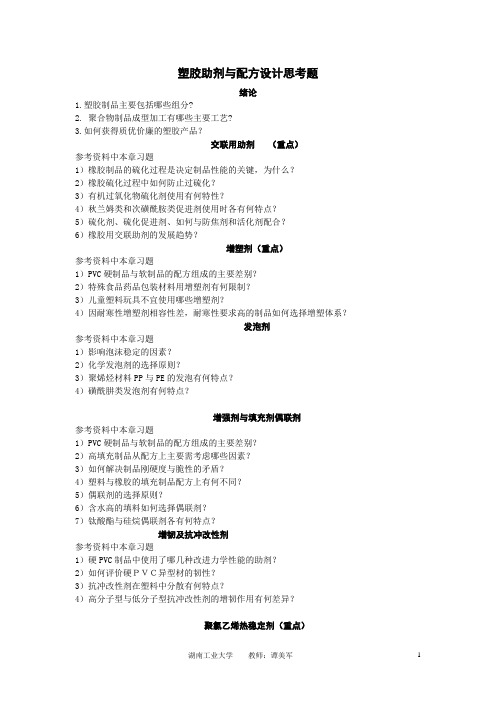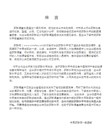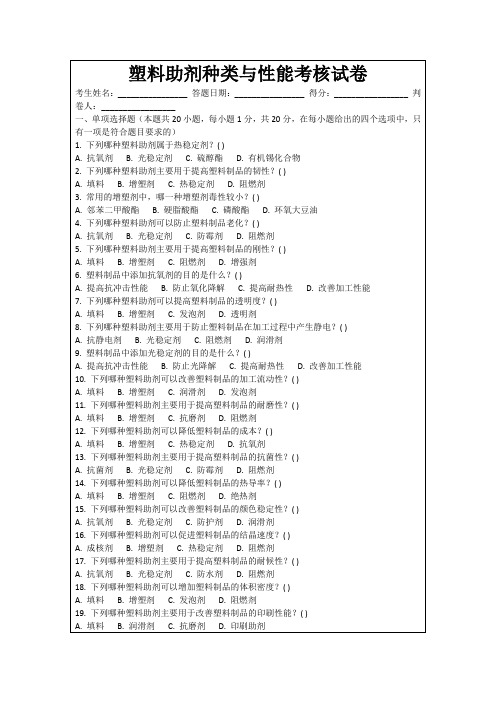塑料加工助剂及配方复习题01.doc
塑料配料工理论复习

塑料配料工理论复习一、选择1、下列不属于通用塑料的是(D )A、PVCB、PEC、PPD、PA2、下列不属于配料前的准备的是(D )A、粉碎B、过筛C、过滤D、加热3、POM是以下哪种物质的缩写( A )A、聚甲醛B、聚氨酯C、聚苯硫醚D、聚酰胺4、塑料配方中各组分的相互关系不包括( D )A、协同作用B、对抗作用C、加和作用D、阻碍作用?5、下列不属于混合扩散运动方式的是(D )A、分子扩散B、对流C、剪切D、置换6、混合效果的评定不包括( C )A、均匀性B、破碎程度C、粒径D、颜色7、玻璃纤维表面处理的基本原则不包括(B )A、极性相近原则B、熔点相近C、形成界面化学键原则D、界面酸碱匹配原则E、引入可塑界面层原则8、大多数塑料属于以下哪种液体(B )A、牛顿性流体B、假塑性流体C、膨胀性流体D、宾汉塑性流体9. PE是指( A )A、聚乙烯B、聚丙烯C、聚氯乙烯D、聚酯10. ABS是指(A )A、丙烯腈-丁二烯-苯乙烯共聚物B、丙烯腈-苯乙烯-丁二烯共聚物C、丁二烯-苯乙烯-丙烯腈共聚物D、苯乙烯-丙烯腈-丁二烯共聚物11. PS原料为无毒、无色透明粒状物,通常的PS都是非晶态的无规聚合物,其密度为( A )A、1.04~1.06g/cm3B、1.24~1.26g/cm3C、1.11~1.12g/cm3 B、1.34~1.36g/cm312. 将固体、液体或气体物料混入液体介质中中的操作称为( A )A、搅拌B、干参混C、捏合D、塑炼13. 大多数塑料属于以下哪种液体(B )A、牛顿性流体B、假塑性流体C、膨胀性流体D、宾汉塑性流体14. 下列不属于工程塑料的是(D )A、PAB、PCC、PETD、PVC15. 单螺杆挤出机的主要参数中L/D表示( A )A、长径比B、膨胀比C、收缩率D、压缩比16. 增强剂和填充剂的主要区别是(A )A、前者能明显提高拉伸强度和弯曲强度,后者只能有所改善B、后者能明显提高拉伸强度和弯曲强度,前者只能有所改善C、前者能明显提高冲击强度和抗张强度,后者只能有所改善D、后者能明显提高冲击强度和抗张强度,前者只能有所改善17. 保持高聚物如塑料、橡胶、合成纤维等稳定,防止其分解、老化加入的试剂是(C )A、抗氧剂B、增塑剂C、热稳定剂D、光稳定剂?18. 润滑剂分为内润滑和外润滑,它也可以当增塑剂(增加塑性),下列哪种说法是正确的( A )。
塑胶助剂与配方设计思考题

塑胶助剂与配方设计思考题绪论1.塑胶制品主要包括哪些组分?2. 聚合物制品成型加工有哪些主要工艺?3.如何获得质优价廉的塑胶产品?交联用助剂(重点)参考资料中本章习题1)橡胶制品的硫化过程是决定制品性能的关键,为什么?2)橡胶硫化过程中如何防止过硫化?3)有机过氧化物硫化剂使用有何特性?4)秋兰姆类和次磺酰胺类促进剂使用时各有何特点?5)硫化剂、硫化促进剂、如何与防焦剂和活化剂配合?6)橡胶用交联助剂的发展趋势?增塑剂(重点)参考资料中本章习题1)PVC硬制品与软制品的配方组成的主要差别?2)特殊食品药品包装材料用增塑剂有何限制?3)儿童塑料玩具不宜使用哪些增塑剂?4)因耐寒性增塑剂相容性差,耐寒性要求高的制品如何选择增塑体系?发泡剂参考资料中本章习题1)影响泡沫稳定的因素?2)化学发泡剂的选择原则?3)聚烯烃材料PP与PE的发泡有何特点?4)磺酰肼类发泡剂有何特点?增强剂与填充剂偶联剂参考资料中本章习题1)PVC硬制品与软制品的配方组成的主要差别?2)高填充制品从配方上主要需考虑哪些因素?3)如何解决制品刚硬度与脆性的矛盾?4)塑料与橡胶的填充制品配方上有何不同?5)偶联剂的选择原则?6)含水高的填料如何选择偶联剂?7)钛酸酯与硅烷偶联剂各有何特点?增韧及抗冲改性剂参考资料中本章习题1)硬PVC制品中使用了哪几种改进力学性能的助剂?2)如何评价硬PVC异型材的韧性?3)抗冲改性剂在塑料中分散有何特点?4)高分子型与低分子型抗冲改性剂的增韧作用有何差异?聚氯乙烯热稳定剂(重点)参考资料中本章习题1)热稳定剂对塑料制品性能有何影响?2)热稳定剂的性能主要受哪些因素影响,如何与其它助剂配合?3)有机锡热稳定剂有何特点?主要用于什么制品中?使用中应注意些什么?4)稀土热稳定剂有何特点?主要用于什么制品中?抗氧剂、光稳定剂、抗菌剂和抗静电剂参考资料中本章习题1)哪类制品对抗氧剂的使用有更多的要求?2)塑料与橡胶制品主要使用的防护助剂分别有哪些?3)聚合物抗氧剂的发展趋势?4).聚合物制品用的光稳定剂如何选择?5)如何评价塑料制品的抗菌性能?6)如何选择食品包装材料中的的抗菌体系?7)哪类制品对抗静电剂的使用有更多的要求?8)如何考虑包装材料中的抗静电体系?9)塑料与纤维制品如何防止静电危害?阻燃剂与抑烟剂(重点)思考题:参考资料中本章习题1)哪类制品对阻燃剂的使用有更多的要求?2)无卤阻燃主要包括哪些?有机磷系阻燃剂有何主要特点?3)聚合物阻燃剂的发展趋势?4)软PVC制品抑烟剂有何要求?5)含硅阻燃剂特点?润滑剂脱模剂(重点)1).塑料加工中哪种工艺对润滑剂要求高?2).哪类塑料制品对润滑剂要求高?3).润滑平衡的意义?如何由塑化曲线分析内外润滑平衡?4).列举常用的塑料制品用润滑剂.5)实验室评价润滑剂的方法有哪些?着色剂参考资料中本章习题1).什么是颜料的色度与色调?2).颜料着色力与遮盖力与哪些因素有关?3).如何选择塑料颜料的分散方法?橡塑制品助剂的配方设计1).针对某一制品如何进行制品配方设计?2).设计一种无毒的医药用塑料包装品配方?3).设计一种无色透明的PVC半硬片配方,可用作食品包装?4).设计一种耐高温绝缘性良好的PVC电缆配方?5).掌握PVC软制品(薄膜、壁纸等)、半软制品(鞋、玩具、包装品)、硬制品(管材、板材,包装片材等、注射件)等设计方法,透明制品,半透明制品日用塑料制品(如塑料桶、包装盒、电线套等)中使用了什么助剂?各有什么要求?6).设计阻燃、防老化、无毒、发泡等特殊功能制品。
配方设计 复习题

2011塑料配方设计复习题1.增塑剂在塑料加工中的主要作用是什么?增塑剂用量最大的一类树脂是什么?衡量增塑剂性能的两个重要指标是什么?2.主要根据哪些性能指标将增塑剂分为主增塑剂和辅助增塑剂?主增塑剂和辅助增塑剂分别主要有哪两大类?分别列出两种常用的主增塑剂和辅助增塑剂,并简要说明其性能特点。
3.PVC类树脂加工时为什么要加入增塑剂、热稳定剂、润滑剂和加工助剂?4.简要说明铅盐类稳定剂、有机锡类稳定剂和金属皂类稳定剂的性能特点。
5.PVC用加工助剂的作用机理?6.在进行PVC制品配方设计时,增塑剂、稳定剂、润滑剂的选用原则各是什么?7.未改性的LLDPE,其加工性能存在哪些缺陷?应当如何改进?8.UHMWPE的加工难点是什么?如何克服?9.PV A的加工特性是什么?如何改进?10.CPVC的加工特性是什么?其配方设计的基本原则是什么?11.POM加工时易热氧降解放出甲醛,所以,在制品加工时通常要加入抗氧剂和甲醛吸收剂。
12.POM为什么难以加工大型制件?13.热塑性聚酯和尼龙加工前,为什么一定要干燥?14.PPO和PTFE加工时都存在什么缺点?各采用什么方式改善?15.塑料填充改性和增强改性的根本区别时什么?16.无机填料表面处理时常用偶联剂,但不同的偶联剂其处理填料的种类也不同,硅烷偶联剂可用来处理哪些填料?碳酸钙和滑石粉常用哪类偶联剂处理?17.有机填料表面处理的主要目的是什么?18.塑料发泡配方设计的几个基本原则是什么?19.发泡时常加入发泡助剂如氧化锌等,其目的是什么?20.发泡时加入交联剂的目的是什么?请举例说明21.塑料增韧改性时,常用的增韧树脂都有哪些,请至少列出5种。
22.什么是原位增强?23.塑料增强改性时,常用的增强材料有哪些?增强材料的表面处理方法有哪些?24.什么是氧指数?美国UL标准的三个阻燃级别分别是什么?25.塑料的燃烧过程包括哪三个阶段?燃烧与哪三个因素有关?26.有卤阻燃和无卤阻燃各有什么特点?27.阻燃配方设计的基本原则是什么?28.引起塑料老化降解的因素主要有哪些?各采用什么办法抑制或避免?29.降解塑料有哪三大类?理想降解塑料应具备哪些基本特征?30.列举几种可完全生物降解的合成塑料。
塑料模复习题.docx

1・什么叫塑料?答:塑料是以树脂为主要成分的高分了材料2.塑料的主要成分是什么?常用的添加剂有哪几种?答:塑料是以聚合物为主体,添加各种助剂的多组分材料。
根据不同的功能,塑料所用的助剂可分为:增塑剂、稳定剂、润滑剂、填充剂、增强剂、交联剂、着色剂、发泡剂等等。
3•根据受热特性不同,塑料可分为哪两种?答:根据合成树脂在受热后所表现的性能不同来划分,一般分为热塑性塑料和热固性塑料两大类。
4•什么叫塑料的收缩性?对塑料成形有什么影响?答:塑件从塑模中取出冷却到室温后,塑件的各部分尺寸都比原來在塑模中的尺寸有所缩小,这种性能称为收缩性。
对塑料成形尺寸有重大影响。
5.塑料的流动性如果很好,对成形有什么影响?答:塑料的流动性好,可以用较小的成型压力充满型腔。
但流动性太好,会在成型吋产生严重的溢边6.ABS的吸湿性较高,在成型之前需怎么做?答:吸湿性塑料在注塑成型过程中比较容易发牛水降解,成型后塑件上岀现气泡、银丝与斑纹等缺陷。
因此,在成型前必须进行干燥处理, 必要时还应在注塑机料斗内设置红外线加热装置,以免干燥后的塑料进入机筒前在料斗中再次吸湿或粘水。
7.注射成型主要适于何种塑料成型?答:注射成形乂称注射模塑或注塑。
主要用于热塑性塑料成型,也用于少量热固性塑料的成型。
8 •简述注射模塑成型的工作循环。
答:有合模、加料塑化、注射、保压、制件冷却、开模和制件顶出等环节。
9.塑料注射机有哪类?答:1)按用途分:热塑性塑料通用注射机和专用注射机(热I古I性塑料注射机、注射吹塑机、发泡注射机、排气注射机等)。
(2)按外形分:卧式注射机、立式注射机、直角式注射机。
(3)按塑料在料筒内的塑化方式分:柱塞式注射机、螺杆式注射机。
10•压缩成型主要适合于何种塑料成型?答:热固性塑料。
11.压注成型成型的塑件时必须考虑哪些因素?答:设计塑件主要适合于何种塑料成型?答:热固性塑料。
12设计注射模吋必须考虑以下因素:(1)、塑料的性能;(2)、模具结构及加工工艺性。
塑料加工助剂及配方复习题01

内润滑剂与外润滑剂;为了降低聚合物分子之间的摩擦(内摩擦),需加入与聚合物有一定相容性的润滑剂,称之为内润滑剂。外润滑剂:一种是在高分子材料成型加工时,将润滑剂涂布在加工设备的表面上,让其在加工温度下熔化,并在金属表面形成一“薄膜层”,将塑料熔体与加工设备隔离开来,不致粘附在设备上,易于脱膜或离辊;另一种是将与聚合物相容性很小,在加工过程中很容易从聚合物内部迁移到表面上,从而形成隔离层的物质,在加工前配料时加入,使其分散到塑料中,而在加工过程中迁移到表面,起到润滑作用。
6,PVC树脂受热降解放出HCl是一个十分复杂的过程,一般有以下三种机理①自由基反应机理;②离子机理;③单分子机理。
7,品种有三大类:即无机阻燃剂,卤素阻燃剂,磷系阻燃剂,约45种。
8,维持燃烧的三要素:可燃物,氧,热。聚合物的燃烧性可用燃烧速度和氧指数。
9, 关于润滑剂的作用机理比较为人们接受的是塑化机理、界面润滑和涂布隔离机理
2、胺类和酚类抗氧剂有何优缺点?酚类具有极好的不变色和不污染性。由于分子量小,挥发性和抽出性较大,影响了抗老化能力。胺类抗氧剂抗氧化效果好,
最大的缺点是具有变色性和污染性,会使聚合物变色,限制了它的应用范围。
3、无卤无机阻燃剂有哪些品种?氢氧化铝,氢氧化镁 ,三氧化二锑 ,硼化合物主要是硼酸锌和硼酸钡,磷系阻燃剂主要有:赤磷(单质),磷酸盐,磷酰胺,磷氮基化合物。
7.4.3 挤塑仪试验:一、混炼型塑化仪
使用混炼型塑化仪试验时,其抗混炼力矩值随时间的变化而变化。硬脂酸铅用量和PVC凝胶化时间的关系如下图所示。由图中可以看出,随着润滑剂添加量的增加抗混炼力矩的最大值相应降低,当硬脂酸铅的添加量增加到1.5~2.0%时,由于润滑性过度塑化物不能包辊,到达屈服点的时间推后,塑化物凝胶化不完全。
塑料原料与助剂应用考核试卷

A.聚乙烯
B.聚丙烯
C.聚苯乙烯
D.玻璃钢
3.塑料助剂中对改善塑料制品的机械性能具有显著作用的是?()
A.填充剂
B.稳定剂
C.润滑剂
D.阻燃剂
4.以下哪种塑料助剂主要用于防止塑料老化?()
A.抗氧剂
B.光稳定剂
C.热稳定剂
D.抗静电剂
5.聚乙烯(PE)的密度是多少?()
A.塑料的结构
B.塑料的添加剂
C.塑料的加工方法
D.塑料的存储条件
15.以下哪些塑料助剂可以改善塑料制品的抗氧化性能?()
A.抗氧剂
B.光稳定剂
C.热稳定剂
D.抗紫外线剂
16.以下哪些是聚乙烯(PE)的应用领域?()
A.食品包装
B.电缆绝缘
C.地板材料
D.汽车零部件
17.以下哪些助剂可以用于改善塑料制品的表面处理?(]
4.在塑料加工过程中,__________是使塑料熔体流动并获得所需形状的关键设备。
5.塑料的__________是指塑料在加热到一定温度时,开始变软并丧失刚性的特性。
6.聚合物分子量的大小通常用__________来表示。
7.下列哪种塑料的密度最小:__________。
8.塑料的__________是指在无外力作用下,塑料材料单位面积的重量。
A.抗氧剂
B.光稳定剂
C.热稳定剂
D.抗紫外线剂
5.以下哪些材料可以用作塑料的填充剂?()
A.玻璃纤维
B.滑石粉
C.木粉
D.二氧化硅
6.塑料制品的缺点包括哪些?()
A.耐热性差
B.易燃烧
C.耐化学性差
塑料原料与助剂两套题

塑料原料与助剂第一套题一、填空(20分) (答案写在答题纸上)1.世界上第一个人工合成塑料是2.聚氯乙烯的生产方法有、、、3.PP是常见塑料品种中密度最小的,其密度大约 g/cm3 ,PP的性能最好;从分子结构上看PP有、、结构4.热塑性塑料力学性能测试时,国家标准规定的环境条件中温度℃,空气相对湿度,大气压 kPa5.ABS中A是起的作用是 B是起的作用是 S是起的作用是。
6. 锦纶、涤纶、丙纶、氨纶在纺织行业上应用的非常广泛,它们对应的塑料品种分别是、、、。
7.常用的工程塑料有、、、、。
8.聚酰胺是由和或缩聚而成的。
PA1010是由和缩聚而成的。
9.由于有些塑料品种的极性较强以吸收空气中的水分,所以在这类聚合物成型加工时需要进行干燥处理,请你写出几种这类塑料品种:、、、。
10.PC的生产方法有和。
11.在热塑性塑料种PMMA在和方面是最优秀的。
12.PE和PP耐候性不是很好的原因是。
13.PMMA在和方面最优秀。
14.合成PU的主要原材料是和。
TDI和MDI 属于。
聚酯型PU和聚醚型PU的分类是按的种类来确定的。
PU最大特点是具有很好的和。
15. PI在方面最优。
聚砜的种类有、、、。
16.PPO在方面最优。
PPS的中文名名称是。
17.耐热性最高的热塑性塑料品种是。
18.享有“塑料王”之称的塑料是,其耐温和性19.PEEKP和PEKK的中文名称是和。
二简答题(30分)(答案写在答题纸上)1、热塑性塑料与热固性塑料的区别(3分)2、塑料的特点是什么?塑料的应用有哪些?(4分)3、试述两种悬浮法生产的聚氯乙烯的区别?(3分)4、聚氯乙烯加工时为什么要添加热稳定剂,所用热稳定及有哪些品种,大约用量是多少?(5分)5目前应用的ABS和传统的ABS相比在组分上有什么变化,有哪些种类的类似聚合物。
(3分)7、PET是一种结晶聚合物,从高分子物理的角度来说明在生产PET类饮料瓶(需透明性好),应注意的工艺问题。
塑料助剂种类与性能考核试卷

5. √
6. ×
7. ×
8. √
9. ×
10. √
五、主观题(参考)
1.塑料助剂可以改善塑料的性能,如提高机械强度、改善加工性能、增加耐热性等。例如,增塑剂用于提高塑料的柔韧性,热稳定剂用于防止塑料在高温下分解。
2.塑料老化现象包括氧化、热降解、光降解、机械磨损等。原因包括紫外线照射、热量、氧气、湿度等环境因素。
四、判断题(本题共10小题,每题1分,共10分,正确的请在答题括号中画√,错误的画×)
1.塑料助剂中,所有的增塑剂都会降低塑料的熔点。()
2.热稳定剂可以提高塑料的耐热性,但不会影响其加工性。()
3.添加填料会降低塑料的透明度。()
4.抗氧剂可以防止塑料在加工和使用过程中的氧化降解。(√)
5.光稳定剂主要防止塑料因紫外线照射而降解。(√)
3.热稳定剂通过捕获自由基、吸收热量等方式减缓或阻止塑料的热分解。在PVC中尤为重要,因为PVC在高温下易分解,影响制品性能。
4.生物降解塑料助剂如淀粉、聚乳酸等,可以加速塑料在自然环境中被微生物分解,减少环境污染,具有环保意义。
A.抗氧剂B.光稳定剂C.硫醇酯D.有机锡化合物
2.下列哪种塑料助剂主要用于提高塑料制品的韧性?( )
A.填料B.增塑剂C.热稳定剂D.阻燃剂
3.常用的增塑剂中,哪一种增塑剂毒性较小?( )
A.邻苯二甲酸酯B.硬脂酸酯C.磷酸酯D.环氧大豆油
4.下列哪种塑料助剂可以防止塑料制品老化?( )
A.抗氧剂B.光稳定剂C.防霉剂D.阻燃剂
塑料助剂种类与性能考核试卷
考生姓名:________________答题日期:________________得分:_________________判卷人:_________________
- 1、下载文档前请自行甄别文档内容的完整性,平台不提供额外的编辑、内容补充、找答案等附加服务。
- 2、"仅部分预览"的文档,不可在线预览部分如存在完整性等问题,可反馈申请退款(可完整预览的文档不适用该条件!)。
- 3、如文档侵犯您的权益,请联系客服反馈,我们会尽快为您处理(人工客服工作时间:9:00-18:30)。
塑料加工助剂及配方复习题01Plastic processing AIDS and formula problemOne, the noun explanation:1,plasticizer; It is the substance that adds plasticity in the plastic system and does not affect the intrinsic properties of the polymer.2,stain; Change the color of the products added in the polymer and improve the cosmetic additives.3,the heat stabilizer; It is mainly used for PVC and otherchlorine-containing polymers, which will not affect its processing and application, but can also be a kind of auxiliary agent to delay its thermal decomposition.4,f1ame retardants: Substances that can increase the flammability of materials are called fire retardants.5,antioxidant: It is a class of chemicals that can be delayed by oxidation of high polymer and ageing.Light stabilizers; Substances that can inhibit or s1ow the process of photooxygenation are called photostabilizers or uv stabilizers.7,lubricants: In order to reduce the high polymer internalfriction and external friction. , improve the liquidity of plastic melt, prevent the polymer material in the processing of equipmentin the process of adhesion phenomenon, ensure the products surface finish and add material called lubricant.8,foaming agent; The foaming agent is a kind of material that can make microporous structure of liquid or plastic in liquid orplastic state in a certain viscosity range.9,coupling agent: Coupling agent is a type of substance that can improve the interface characteristics of the packing and polymer materials.Antistatic agent; Add in resin, fuel or attached on the surface of the plastic products, synthetic fiber, to prevent the polymer materials and liquid fuels of electrostatic hazard chemical additives are collectively referred to as antistatic agent.11, oxygen index; This is the minimum oxygen required in the nitrogen and oxygen flow when the sample is burned continuouslylike a candle.Foam aid; In the foaming process, those that can adjust and foaming agent and foaming agent decomposition temperature and decomposition rate of the material, or can improve the foaming process, stable foam structure and improve the quality of foam material, can be referred to as foaming agent, or auxiliary blowing agent.13, tinting strength; Refers to the ability of pigment to affect the color of the whole mixture. The color is large and the dose is small and the cost is 1 ow.14, hiding power: The ability to stop light from penetrating the tinted product, in other words, is a matter of the size of the stain. The larger the mask, the worse the transparency.Metal ion passivating agent; A substance that prevents heavy metal ions from causing oxidation to the polymer.16,anti-reflection agent. A booster that can improve crystal polymer transparency.17,the plasticizer: introducing a second monomer in polymer polymerization process, because of the second monomer copolymerization in the molecular structure of the polymer, thus reduced the crystallinity of polymer molecular chain. Or the introduction of a branch chain (or branch of a branch) in the polymer chain. And the branched chain can reduce the force between the polymer chain and the chain, thereby increasing the plastic,s plasticity. External plasticizer: the less volatile liquid or low melting solids in addition to the high boiling point in the polymerization system.Main plasticizer and auxiliary plasticizer; If plasticizer crystallization of polymer molecules can only be inserted into the part of the amorphous region, then this plasticizer is solvent plasticizer, namely auxiliary plasticizer.If plasticizer can be inserted into the polymer molecules of amorphous regions at the same time can be inserted into the crystallization area, then this plasticizer is solvent plasticizer, which is the main plasticizer.The efficiency of plasticization; The plasticization efficiency of the plasticizer is called the amount of plasticizer that makes the resin reach a certain degree of softness.20, main antioxidant and auxiliary antioxidant; The main antioxidant is regarded as a radical cleaner, it through coupling reaction (i. e. termination reaction) or give a hydrogen atom to prevent damaging effects of free radicals in the polymer. The most commonly used antioxides are phenols, followed by amines. The role of an antioxidant is to decompose the peroxide produced by the oxidative polymer oxidation.Internal lubricants and external lubricants; In order to reduce friction between polymer molecules (internal friction), you need to add lubricants that are compatible with polymers, called internal lubricants.Lubricants: one kind is in polymer materials processing, the lubricant coating on the surface of the processing equipment, let it melt under the processing temperature, and form a "thin layer" on the metal surface, isolates plastic melt and processing equipment, not adhesion on the device, easy to take off the membrane or roll; Another kind is the compatibility with polymer is very small, in the process of machining easily migrate to the surface, from inside the polymer to form isolation layer material, ingredients to join before processing, make its dispersion in the plastic, and migrate to the surface in the process of machining, the lubrication effect.2, fill in the blanks:Analysis of the main factors of plasticization: the intermolecular forces of the polymer, the hydrogen bonding, the crystallinity of the polymerTheory of plasticizer: lubrication, gel, free volume, etcAntioxygenation: chain terminated antioxidant (or free radical inhibitor), the main antioxidant; Prophylactic antioxidant (including peroxide dissociation agent, metal ion passivation, etc.) is auxiliary antioxidant. According to structure: amine, phenol, sulfur compound, phosphor compound, organic metal salts etc.The disadvantage of amines is that they are toxic, polluting, discoloration and their own ease of oxidation. Phenols aregenerally less toxic, not discolored, and not polluted. The antioxides of phosphates have the advantages of low toxicity, non-pollution and low volatility.There are many reasons for the ageing of the polymer materials. Physical factors: light, heat, stress, electric field, rays, etc. Chemical factors: oxygen, ozone, heavy metal ions, chemical media etc. Biological factors include microorganisms, insects, etc.The heat degradation of PVC resin is a very complicated process,and there are three kinds of mechanism. Ion mechanism; Themolecular mechanism.There are three kinds: inorganic flame retardant, halogen flame retardant, phosphor flame retardant, about 45 kinds.The three elements that sustain combustion: fuel, oxygen, heat. The burning of the polymer can be used for burning speed and oxygen index.The mechanism of plasticization, interface lubrication and coatingisolation mechanism are acceptedAccording to its way of producing bubbles in the foaming process, the foaming agent can be divided into two types: physical foaming agent and chemical foaming agent. For chemical foaming agents, twoof the most important technical indicators are the decomposition of temperature and air volume. Common methods for the determination of foaming agent are: differential thermal analysis, thermalweightless method and so on.The current widely used antistatic agent is mainly classified as cationic, anionic, non-ionic, amphoteric, and high polymer.The pigments and pigments used in plastics and rubber are mainly inorganic pigments, organic pigments and dyes.The mechanism of the coupling agent, using the example of silane or titanate coupling agent, is used to write the correspondingchemical equation.Chemical theory: the theory is that coupling agent containing a chemical functional groups, with glass fiber surface silanol groups or other inorganic filler on the surface of the molecular form covalent bonds. In addition, the coupling agent containing at least one other different functional groups and polymer molecular bonding, in order to obtain the good interface bonding, coupling agent is to play a bridge of mutual connection between inorganic and organic facies role. Silane coupling agent general formula can be writtenas RSiX3, in which R is reaction with polymer molecules haveaffinity and ability of active functional groups, such as vinyl chloride propyl, epoxy group, methyl propylene acyl amine andsulphur, etc. X is an alkane that can hydrolyze, such as methoxy, ethoxy, etc. Such as ammonium propyl triethoxy silane NH2CH2CH2 - CH2Si (OC2H5) 3, when using it first with inorganic filler (such as glass fiber, etc.), silane hydrolysis into silanol first, then the silicon alcohol-based and inorganic filler surface produces dehydration reaction, in chemical bonds:In the preparation of composite materials, the Y group of the coupling agent will interact with the organic polymer.In the end, the bridge between inorganic and organic materials, such as the coupling of epoxy resin. Through the above two reactions, silane coupling agent by chemical bonds combined with improved polymer and inorganic fillers in composite materials, the adhesion between the performance is greatly improved. Titanate coupling agent for filler type thermoplastic polymer and drying, good coupling effect, this kind of coupling agent can use general formula: (R00 (4 - n) Ti (OXR ' Y) n (n = 2, 3). The RO - is hydrolyzable alkoxy short carbon chain, can react with inorganic surface hydroxyl groups, so as to achieve the purpose of chemical coupling; - weather can be a carboxyl, alkoxy, sulfonic group, phosphorus, etc., these groups are important, decided to titanate have special performance.Four, the analysis problem gives the experiment graph, the analysis experiment result (abbreviated).7.4.2 extrusion test commonly used experimental extruder, by changing the rotating speed of extruder in the test, to determine the torque of the screw, the screw extrusion side pressure and the amount of change, the typical extrusion test curve as shown in thefigure below.Curve 3 shows that the lubrication is overdone, the torque is not up, the extrusion pressure is reduced, and the output per minute is down, which is very bad for production.7. 4. 3 extrusion machine test: one, mixed smelting machineIn the experiment of the mixtures, the torque value of the anti-mixing torque was changed over time. The relationship between the use of stearate and PVC gel time is shown below. As you can see by the picture, with the increase of lubricant additives, mixing the maximum torque resistance reduced when the adding amount of lead stearate increases to 1. 5 " 2. 0%, due to the lubrication excessive plastic compound can,t pack roller, time of arrival in the yield point later, plastic compound gel was incomplete.What is a plasticizer? What are the main functions of plasticizers? What physical properties will change after adding plasticizers to the polymer? How to change?Plasticizer is a substance that adds plasticity to the plastic system and does not affect the nature of the polymer.Plasticizer: the main function of weakening the van der Waals force between the polymer molecules, increase the mobility of the polymer molecular chain, reduce the crystallization of polymer molecule chains, i. e. the increase plastic plastic. The elongation, flexibility and flexibility of plastic have been improved, while hardness, modulus, softening temperature and brittle temperature have all declined.What are the advantages and disadvantages of the amine and phenol antioxidant? Phenols have excellent discoloration and non-pollution. Because the molecular weight is small, the volatile and the extraction is larger, the anti-aging ability is affected. Amine antioxidant is good,The biggest drawback is that discoloration and pollution make the polymer change color, limiting its application.What kinds of non-halogen inorganic f 1 ame retardants? Aluminum hydroxide, magnesium hydroxide, antimony trioxide, boron compounds mainly zinc borate and boric acid barium, phosphorus-containing flame retardants mainly include: red phosphorus (elemental), phosphate, phosphoramide, phosphorus and nitrogen compounds.What are the pros and cons of lead stabilizers? The main advantages of lead stabilizer: thermal stability, especially long-term heatand implicit characterization; Good electrical insulation; It has the properties of white pigment, and it is very strong. As anactive agent for foaming agent: Lubricity; Prices are low. The disadvantages of lead stabilizers: poor transparency of the products; Toxicity; Poor dispersion; It is easily contaminated by hydrogen sulfide. Because of the dispersion difference, therelative density is large, so the quantity is large, often up to five.What are the categories of light stabilizers according to the mechanism of action? (1) light screening agents, including black carbon, zinc oxide and some inorganic pigments; (2) uv absorbers, including salicylate, diphenylketone, benzene and triazole, substituting acrylonitrile, triazine, and other organic compounds;(3) the quenched agent, mainly the organic complex of nickel: (4) the free radical capture agent, which is mainly a blocked amine derivative.What kinds of auxiliaries can be used for chlorinated paraffin? Depending on the amount of chlorine, the effect is different. The chlorine content is more than 70% and can be used as a flame retardant. About 50% of the chlorinated paraffin, which is used as a plasticizer, is mainly used as a lubricant.。
